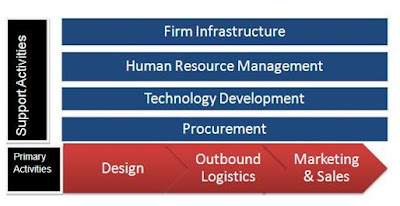Firm Infrastructure
It was Ortega’s,
the founder of Inditex, visionary management style which led Inditex towards
success. It was his concept to deliver fashion quick because he was interested
in revolutionalizing the apparel industry where the customers must regard
clothing as a perishable commodity. To serve his viewpoint integration of
designing, manufacturing & distributions were integral to the fast-fashion
concept. Most of Inditex’s
competitors adopt an outsourcing strategy by outsourcing all production to the
external suppliers whereas Inditex maintains its production processes in house.
The supply chain structure is vertically integrated.
 |
| Brands which make Inditex |
Human Resources Management (HRM)
Inditex is an
employer to more than hundred thousand individuals coming from 150
nationalities.Many of the
Inditex’s current managers began their careers as store employees or other
entry level positions. There performance was recorded and talented employees
were promoted.Orientation of new employees & training of existing employees
adapting to their needs is given importance in the organization.
Technology Development
Inditex achieved
a competitive edge over its competitors by developing a quick response system
to fashion trends & for this it had to develop state-of-the-art IT system
which is integrated throughout the supply chain.
There is
constant exchange of information through every part of supply chain which
includes shop managers, designers, production staff, and external clothing
manufacturers. Sales data, from different geographical locations, is processed
& passed along to designers. This helps the designers to cater their
designs to the preferences of the customers. The effective use of IT makes
Inditex capable to produce very fast turnaround for its fashion designs.
Procurement
Inditex
outsources less production than its competitors. Inditex outsources some of its
standardardized products like cotton T-shirts which are price-sensitive to Asia
as these products have longer shelf lives.
Majority of the
Inditex’s supplier factories are in Spain and Portugal and these factories
specialize in fashion-customised sewing. The proximity of these factories,
specializing in the manufacture of fashionable garments, to the distribution
facility saves time and transportation costs. This allows Inditex to respond quickly
to fashion trends hence reducing its product risk.
Design
The demand in
the fashion apparel industry keeps on fluctuating and any failure to meet the
latest demands can be very risky and deteriorate the customer loyalty. Products
may become out of fashion even before reach shelves. This can undermine the
entire value chain. Hence, to avoid such a risk Inditex encourages continuous
exchange of information between the store managers, designers, procurement
teams and marketing specialists to ensure that the designs are exclusive &
customer driven.
 |
| One of the most successful fast-fashion concept chain |
Outbound Logistics
The aim is to
immediately transfer the products rather than storing them. The schedule is
clearly defined which focuses on deadlines on every stage in the supply chain.
This helps to save costs and time by eliminating the need of intermediary
warehouses to store inventory. This effective way of distribution helps Inditex
maintain a strong position in the market.
Marketing and Sales
Inditex’s
marketing budget compared to its competitiors is very less. It infact prefers
to entice customers by selecting prime locations & having its new clothing
displayed in its shop windows.
 |
| Exclusive clothing on display |
There are reasons
for this. Firstly, the clothings range changes frequently, hence any
advertising activity has to be in line with the latest clothing ranges and this
might be expensive. Secondly, Inditex avoids over-exposure of its limited
clothing ranges & focusses on the presentation of the stores. It is
interested in creating a climate of exclusivity and scarcity so that customers
are encouraged to buy.




